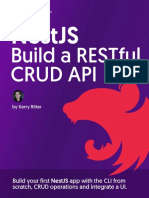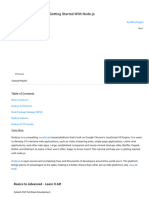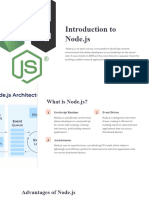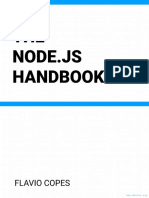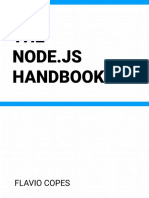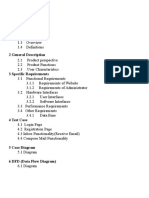23:18 6/7/25 Documentation | NestJS - A progressive Node.
js framework
dark_mode
https://docs.nestjs.com 1/4
�23:18 6/7/25 Documentation | NestJS - A progressive Node.js framework
Introduction
Nest (NestJS) is a framework for building efficient, scalable Node.js server-side applications. It uses progressive
JavaScript, is built with and fully supports TypeScript (yet still enables developers to code in pure JavaScript) and
combines elements of OOP (Object Oriented Programming), FP (Functional Programming), and FRP (Functional
Reactive Programming).
Under the hood, Nest makes use of robust HTTP Server frameworks like Express (the default) and optionally can be
configured to use Fastify as well!
Nest provides a level of abstraction above these common Node.js frameworks (Express/Fastify), but also exposes
their APIs directly to the developer. This gives developers the freedom to use the myriad of third-party modules
which are available for the underlying platform.
Philosophy
In recent years, thanks to Node.js, JavaScript has become the “lingua franca” of the web for both front and backend
applications. This has given rise to awesome projects like Angular, React and Vue, which improve developer
productivity and enable the creation of fast, testable, and extensible frontend applications. However, while plenty
of superb libraries, helpers, and tools exist for Node (and server-side JavaScript), none of them effectively solve the
main problem of architecture.
Nest provides an out-of-the-box application architecture which allows developers and teams to create highly
testable, scalable, loosely coupled, and easily maintainable applications. The architecture is heavily inspired by
Angular.
Installation
To get started, you can either scaffold the project with the Nest CLI, or clone a starter project (both will produce
the same outcome).
To scaffold the project with the Nest CLI, run the following commands. This will create a new project directory, and
populate the directory with the initial core Nest files and supporting modules, creating a conventional base
structure for your project. Creating a new project with the Nest CLI is recommended for first-time users. We'll
continue with this approach in First Steps.
$ npm i -g @nestjs/cli
$ nest new project-name
https://docs.nestjs.com 2/4
�23:18 6/7/25 Documentation | NestJS - A progressive Node.js framework
HINT
To create a new TypeScript project with stricter feature set, pass the --strict flag to the nest new
command.
Alternatives
Alternatively, to install the TypeScript starter project with Git:
$ git clone https://github.com/nestjs/typescript-starter.git project
$ cd project
$ npm install
$ npm run start
HINT
If you'd like to clone the repository without the git history, you can use degit.
Open your browser and navigate to http://localhost:3000/ .
To install the JavaScript flavor of the starter project, use javascript-starter.git in the command sequence
above.
You can also start a new project from scratch by installing the core and supporting packages. Keep in mind that
you'll need to set up the project boilerplate files on your own. At a minimum, you'll need these dependencies:
@nestjs/core , @nestjs/common , rxjs , and reflect-metadata . Check out this short article on how to create a
complete project: 5 steps to create a bare minimum NestJS app from scratch!.
Support us
Nest is an MIT-licensed open source project. It can grow thanks to the support of these awesome people. If you'd
like to join them, please read more here.
Principal Sponsors Sponsors / Partners
Become a sponsor
https://docs.nestjs.com 3/4
�23:18 6/7/25 Documentation | NestJS - A progressive Node.js framework
Become a sponsor
Join our Newsletter
Subscribe to stay up to date with the latest Nest updates, features, and videos!
Email address..
Copyright © 2017-2025 MIT by Kamil Mysliwiec design by Jakub Staron
Official NestJS Consulting Trilon.io hosted by Netlify
https://docs.nestjs.com 4/4









